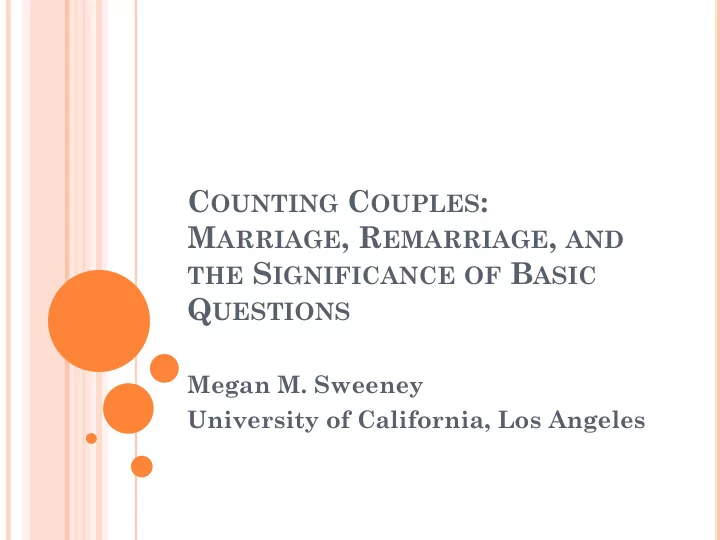

C OUNTING C OUPLES : M ARRIAGE , R EMARRIAGE , AND THE S IGNIFICANCE OF B ASIC Q UESTIONS Megan M. Sweeney University of California, Los Angeles
W HAT ARE WE TRYING TO MEASURE , AND WHY ? Given the substantial share of marriages begun by non-marital cohabitation and which do not last a lifetime … Is it still important to study marriage separately from other forms of intimate partnership? Is it important to distinguish first marriages from higher-order marriages? How is marital status best measured in the context of increasing availability of marriage to same-sex couples?
W HY STUDY MARRIAGE ? Marriage… is associated with relatively better health and economic well-being than cohabitation. is associated with widely-shared expectations about formal and informal interactions, roles and obligations, and long-run commitment. remains more stable, on average, than other relationship types. confers specific legal and economic rights and responsibilities.
W HY STUDY REMARRIAGE ? Remarriage is associated with weaker economic, social, and health benefits than first marriage, although reasons for these differences are not yet well understood. Public policy efforts to encourage marriage among single parents would in many cases result in a remarriage rather than first marriage. Remarriage can provide important insights into the institution of marriage itself. Insights to be gained from understanding how remarriage differs from first marriage, from other post-marital unions, how the context and consequences associated with marriage vary over the life course, etc.
D ATA NEEDS Large sample sizes needed to reliably monitor marriage and remarriage for relatively small subpopulations (e.g., specific racial or ethnic groups, immigrant populations, same-sex couples) Broad coverage of the U.S. population (including various stages of the life course) Information on context – geographic residence (states!), other individual-level and community- level correlates Current marital status & marital history Should also include information on experiences of nonmarital relationships
C HANGING LANDSCAPE OF FEDERAL DATA TO STUDY MARRIAGE AND REMARRIAGE Loss of Census age at first marriage question after 1980 Loss of detailed national information on marriage and divorce from vital statistics after 1995 Loss of marriage history supplement to June CPS after 1995 Full sample of National Survey of Families and Households (NSFH) last interviewed in 1992-94. This data set broadly covered U.S. population and was widely analyzed by family demographers.
S OME KEY CURRENT FEDERAL DATA SOURCES American Community Survey (ACS) Very large sample sizes, estimates at state level, broad coverage by age, coverage of institutionalized populations BUT only limited info on marital history -- basic questions added in 2008 (# times married, year of last marriage, experience of marriage/widowhood/divorce in past 12 months) -- limited info on potential correlates of marriage / remarriage, no cohabitation histories. Survey of Income and Program Participation (SIPP) Large sample sizes, broad coverage by age, more extensive marital histories than ACS BUT not designed to produce annual state-level estimates of marriage / remarriage, no cohabitation histories
K EY CURRENT FEDERAL DATA SOURCES , CONTINUED … National Survey of Family Growth (NSFG) Includes detailed histories of marriage and cohabitation, sample sizes smaller than ACS or SIPP, but can be increased by pooling multiple rounds of the survey. BUT age-based sampling design, limited to men and women ages 15-44. (Note – this is a particularly important limitation for the study of remarriage.)
M EASUREMENT OF S AME -S EX M ARRIAGES Growth in the availability of legal marriage to same-sex couples has outpaced development of appropriate procedures to measure these couples Federal agencies have routinely edited raw data in ways that affects counts of same-sex partners and spouses. These procedures are complicated and have changed substantially over a short time span. Stigma, fear of discrimination, dissatisfaction or confusion with question wording also affects reports of same-sex spouses (e.g., Gates 2010)
M EASUREMENT OF SAME - SEX MARRIAGE Census FAQ: How do same-sex couples answer the relationship question? Census data are based on how individuals self identify and how couples think of themselves. Same-sex couples who are married, or consider themselves to be spouses, can identify one other adult as a “husband or wife.” Source: http://2010.census.gov/partners/pdf/factSheet_Ge neral_LGBT.pdf
S OME PARTING THOUGHTS … It remains important to measure and monitor marriage and remarriage. Such work will be most effective and useful to policymakers and scholars when data: include large samples sizes can produce estimates at the state or local level include information on marital histories and other types of relationship histories include information on likely correlates of union transitions. May be worth considering targeted changes to existing data such as the addition of cohabitation histories to the SIPP, modifying the upper age limit of NSFG, new sample survey with broad coverage of the U.S. population.
S OME PARTING THOUGHTS , CONTINUED … Important to clarify motivations of policymakers and scholars for studying same-sex marriage Are these motivations best served by measuring legally contracted marriages, legally recognized marriages in state of residence, subjective identification as married? If multiple motivations exist, then multiple measurement approaches are needed. Greater transparency about editing procedures needed, and researchers should be given access to raw (unedited) microdata whenever feasible. More exploratory work needed to better understand ways in which question wording and data processing influence validity of final counts of same-sex partners and spouses.
Recommend
More recommend